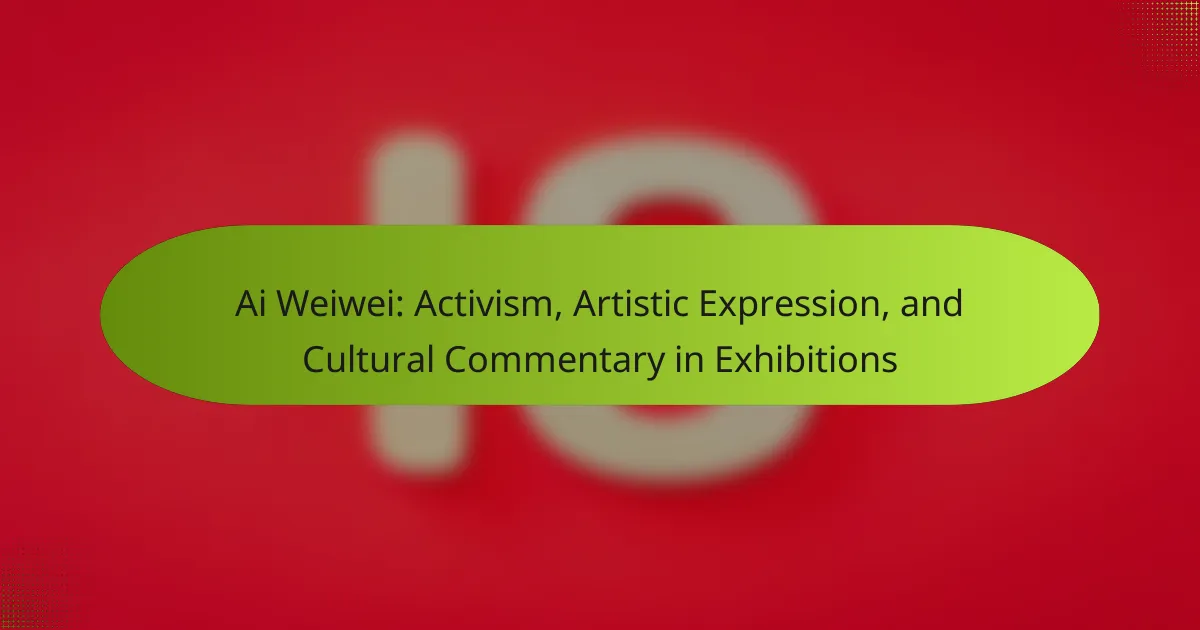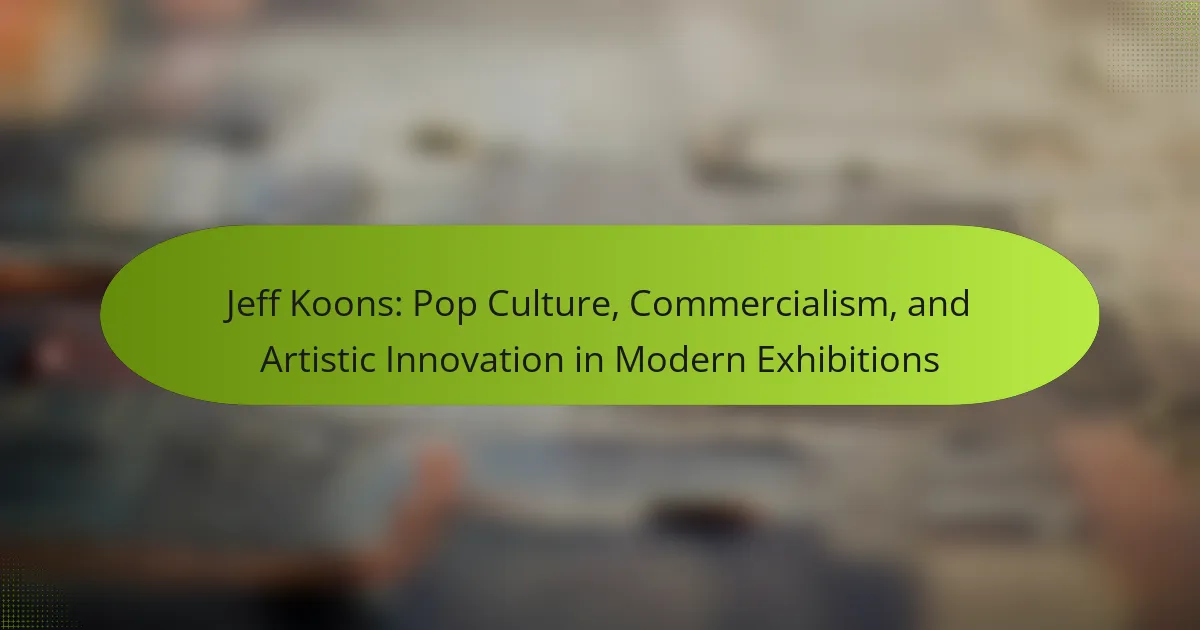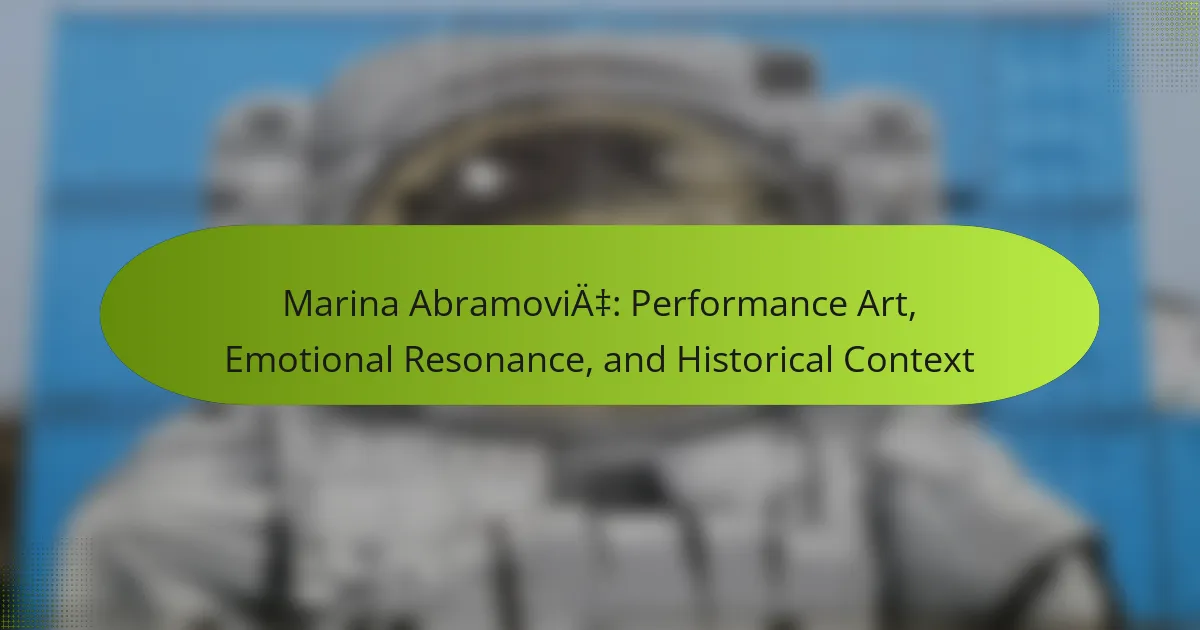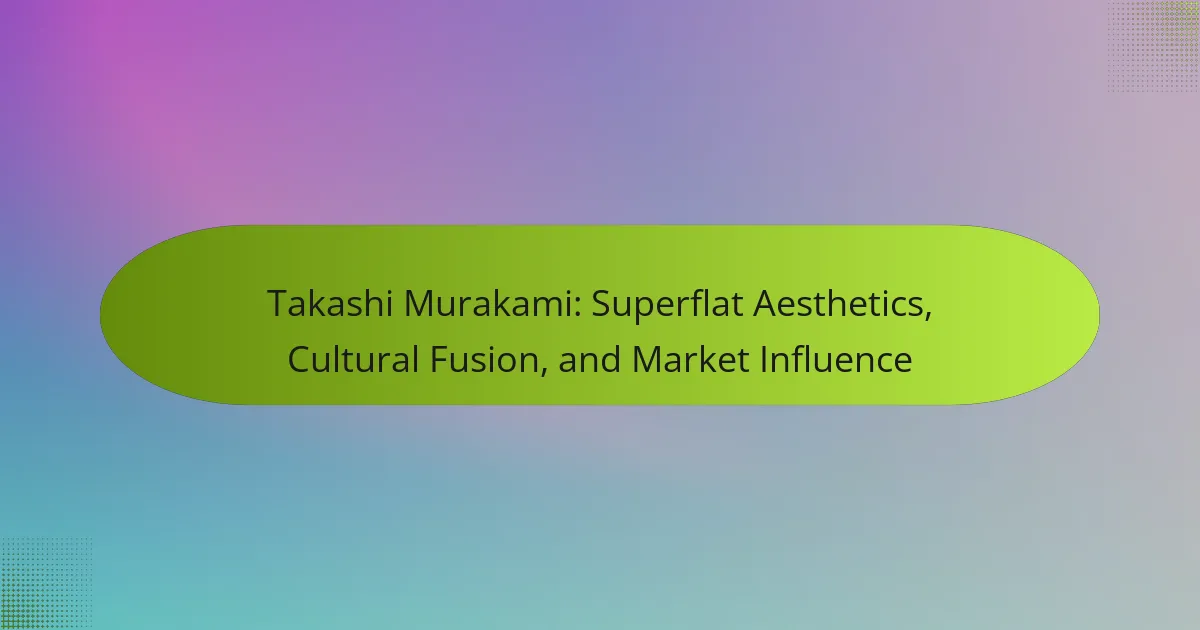Damien Hirst’s art challenges perceptions of mortality and value through provocative concepts and unconventional materials. His innovative use of formaldehyde and pharmaceuticals critiques the art market while exploring themes of beauty and decay. Market trends significantly impact the valuation of his works, reflecting collector preferences and economic conditions. Cultural context also shapes audience interpretations, enhancing the dialogue around his exhibitions and their influence on contemporary art.

What are the core provocative concepts in Damien Hirst’s art?
Damien Hirst’s art is defined by provocative concepts such as mortality, value, and the nature of art itself. His use of unconventional materials, like formaldehyde and pharmaceuticals, challenges traditional perceptions. Hirst’s work often critiques the art market, emphasizing the interplay between art and commerce. His installations provoke deep emotional responses, questioning life and death, while also engaging with themes of beauty and decay.
How does Hirst challenge traditional notions of mortality?
Damien Hirst challenges traditional notions of mortality by using provocative materials and concepts in his art. His works often confront viewers with the stark reality of death, as seen in pieces like “The Physical Impossibility of Death in the Mind of Someone Living,” where a preserved shark in formaldehyde symbolizes the fragility of life. Hirst’s unique approach combines artistic expression with themes of decay, prompting reflection on the human condition. This perspective reshapes how audiences engage with the idea of mortality, transforming it from a taboo subject into a focal point for contemplation and discussion.
What role does shock value play in Hirst’s exhibitions?
Shock value plays a critical role in Damien Hirst’s exhibitions by provoking strong emotional responses. This strategy challenges viewers’ perceptions of art and morality. Hirst’s use of controversial materials, such as preserved animals, emphasizes themes of life and death. As a result, his work often sparks debate, enhancing market trends and audience engagement. The unique attributes of his exhibitions, such as their boldness and unpredictability, contribute to their lasting impact in the contemporary art scene.
Which themes of consumerism and commodification are prevalent in his work?
Damien Hirst’s work prominently features themes of consumerism and commodification. His art challenges the boundaries between art and commercialism, often transforming unique pieces into marketable commodities. Hirst’s use of materials like formaldehyde and diamonds emphasizes the value placed on objects in contemporary culture. As a result, his exhibitions often reflect the commercialization of art, raising questions about authenticity and artistic intent.

What materials does Damien Hirst use to create his art?
Damien Hirst uses a variety of materials, including formaldehyde, paint, glass, and bronze, to create his art. His works often incorporate unconventional elements like spot paintings, preserved animals, and intricate sculptures. Hirst’s use of materials reflects his exploration of themes such as life, death, and consumerism. Notably, his unique approach to materials contributes to the provocative nature of his exhibitions.
How do unconventional materials influence the perception of his pieces?
Unconventional materials significantly enhance the perception of Damien Hirst’s pieces by challenging traditional artistic norms. These materials, such as formaldehyde and surgical instruments, evoke strong emotional responses. They provoke thought on life, death, and the value of art, making his exhibitions memorable. This unique approach differentiates Hirst in the contemporary art market, attracting diverse audiences and stimulating discussions.
Which specific materials are signature to Hirst’s style?
Damien Hirst’s style is signatured by materials such as formaldehyde, glass, and natural specimens. His use of these materials creates provocative installations that challenge perceptions of life and death. Formaldehyde is essential in preserving animal specimens, while glass allows for transparent viewing of intricate details. Additionally, Hirst often incorporates paint and stainless steel, enhancing the visual impact of his works. These materials contribute to the unique and controversial nature of his art, reflecting his exploration of mortality and existence.
What innovative techniques does Hirst employ in his art production?
Damien Hirst employs innovative techniques such as unique materials, scientific processes, and interactive installations to create provocative art. He often uses unconventional mediums like formaldehyde and spot paintings, enhancing viewer engagement. Hirst’s integration of technology, including digital art and augmented reality, further distinguishes his exhibitions. These methods reflect market trends and challenge traditional art concepts.

How do market trends affect the valuation of Damien Hirst’s works?
Market trends significantly influence the valuation of Damien Hirst’s works. The demand for contemporary art, particularly pieces that challenge traditional norms, can drive prices higher. Economic conditions, collector preferences, and exhibition visibility also play crucial roles. For instance, Hirst’s innovative use of materials, such as formaldehyde and spot paintings, aligns with current trends favouring unique artistic expressions. As a result, market fluctuations can lead to substantial changes in the perceived value of his art.
What factors contribute to the fluctuating prices of Hirst’s art?
Market demand, artist reputation, and economic conditions contribute to fluctuating prices of Damien Hirst’s art. Limited edition works and unique concepts can drive higher valuations. Additionally, auction results and collector interest influence market trends. Changes in public perception of Hirst’s provocative themes also impact prices.
How do auction results reflect Hirst’s market position?
Auction results demonstrate Damien Hirst’s strong market position through high sale prices and consistent demand. His works frequently achieve record-breaking bids, reflecting both collector interest and the investment potential of his art. Notably, Hirst’s unique blend of provocative themes and innovative materials contributes to his market resilience. For instance, his 2017 auction saw pieces sell for millions, underscoring his rare ability to captivate buyers. These trends position Hirst as a leading figure in contemporary art, influencing market dynamics.
Which demographic trends are influencing demand for Hirst’s art?
Demographic trends significantly influence demand for Damien Hirst’s art. Younger collectors, particularly millennials and Gen Z, seek innovative and provocative works that challenge conventional norms.
Additionally, an increase in disposable income among affluent individuals drives interest in contemporary art. The rise of digital platforms also enables broader access to Hirst’s art, appealing to a global audience. This shift in demographics reflects a growing appreciation for unique artistic expressions and investment in contemporary art.
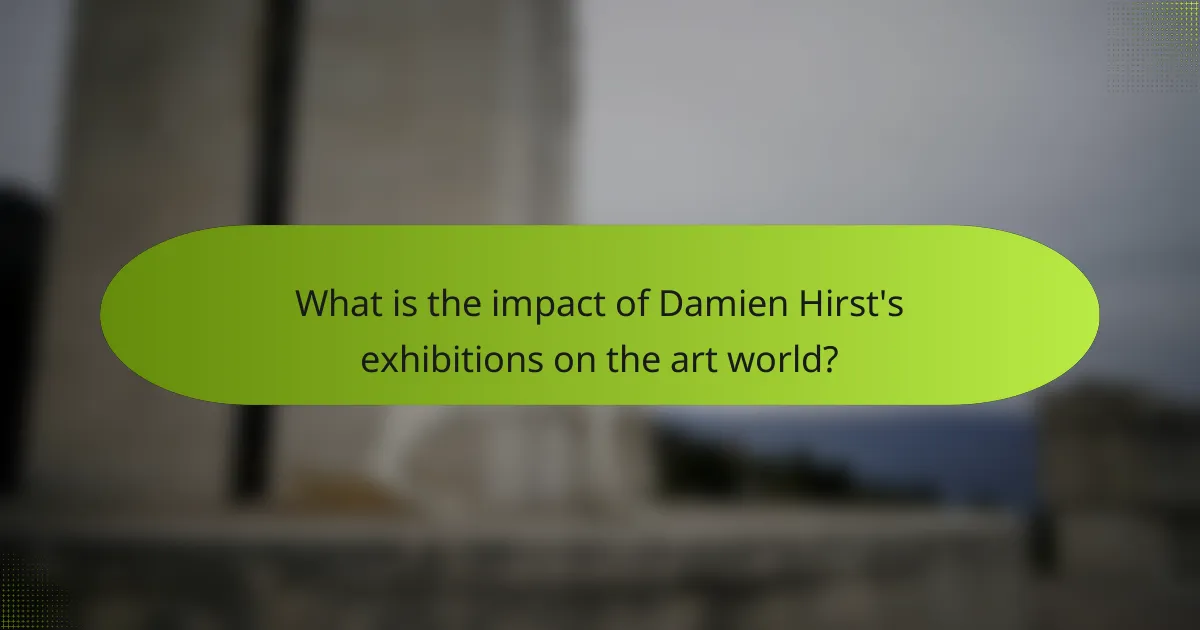
What is the impact of Damien Hirst’s exhibitions on the art world?
Damien Hirst’s exhibitions significantly influence the art world by challenging traditional concepts and market dynamics. His provocative use of materials, such as preserved animals and pharmaceutical themes, pushes boundaries and sparks debate. Hirst’s ability to create high-value art pieces, often fetching millions at auctions, reshapes market trends and elevates the status of contemporary art. His exhibitions attract large audiences, enhancing public engagement with modern art and fostering a new appreciation for unconventional forms.
How do his exhibitions shape contemporary art discourse?
Damien Hirst’s exhibitions significantly influence contemporary art discourse by challenging traditional boundaries and provoking critical dialogue. His provocative concepts often utilize unconventional materials, such as preserved animals and pharmaceuticals, which invite viewers to confront ethical and existential questions.
Moreover, Hirst’s approach to market trends reshapes perceptions of value in art, blurring the lines between commodification and artistic integrity. As a result, his work stimulates discussions on the role of the artist in a commercialized environment. Hirst’s unique ability to intertwine art with popular culture ensures his exhibitions remain relevant and impactful, prompting ongoing debates within the art community.
What role do collaborations play in enhancing Hirst’s visibility?
Collaborations significantly enhance Damien Hirst’s visibility by expanding his reach and influence in the art world. Partnering with other artists, brands, or institutions creates unique opportunities for cross-promotion and audience engagement. These collaborations often lead to innovative exhibitions that attract media attention, thereby amplifying Hirst’s presence in contemporary art discussions. Furthermore, collaborations can introduce Hirst to new demographics, broadening his market appeal and reinforcing his status as a leading figure in provocative art.
Which notable exhibitions have defined Hirst’s career trajectory?
Damien Hirst’s career has been defined by notable exhibitions like “The Physical Impossibility of Death in the Mind of Someone Living” in 1991, showcasing his unique use of preserved animals. Another significant exhibition is “For the Love of God” in 2007, featuring a diamond-encrusted skull that exemplified his provocative approach to art and commerce. “Beautiful Inside My Head Forever” in 2008 further solidified his market trends, achieving record auction prices. These exhibitions highlight Hirst’s ability to blend controversial concepts with market dynamics.

How does cultural context influence the reception of Hirst’s work?
Cultural context significantly influences the reception of Damien Hirst’s work, impacting how audiences interpret his provocative concepts. Different cultures may perceive themes of mortality, consumerism, and art’s value through varied lenses. For example, Hirst’s use of animals in formaldehyde can evoke strong reactions based on cultural views on life and death. In Western contexts, his work often sparks debates about artistic merit and commercialism, while in other cultures, it may be seen as a bold commentary on existential themes. This variation highlights Hirst’s unique ability to engage with diverse audiences, shaping his market trends and exhibition success.
What differences are observed in Hirst’s reception across various regions?
Damien Hirst’s reception varies significantly across regions due to cultural perspectives and market dynamics. In Europe, his work often faces critical scrutiny for its provocative nature, while in Asia, there is a growing appreciation for his bold concepts and materials. North America exhibits a mixed response, with some embracing his contributions to contemporary art and others questioning their artistic value. Factors such as local art market trends, historical context, and audience demographics heavily influence these regional differences.
How do local art markets respond to Hirst’s provocative style?
Local art markets often embrace Damien Hirst’s provocative style, leading to increased interest and sales. His unique use of materials and concepts challenges traditional norms, attracting diverse audiences. As a result, galleries frequently host exhibitions featuring his works, enhancing local cultural engagement. The market responds with heightened demand for similar innovative artists, fostering a trend toward boundary-pushing art.
Which cultural events or movements resonate with Hirst’s themes?
Damien Hirst’s themes resonate with movements like conceptual art, postmodernism, and the art market’s commercialization. These cultural events challenge traditional notions of art, emphasizing ideas over aesthetics. For example, the rise of conceptual art in the 1960s parallels Hirst’s focus on provocative concepts. Additionally, the commodification of art in contemporary markets reflects Hirst’s engagement with value and perception. The Dada movement’s anti-art stance also aligns with Hirst’s subversion of artistic norms. Overall, these cultural movements enhance the understanding of Hirst’s work and its impact on the art world.
What are the best practices for engaging with Damien Hirst’s art?
To engage effectively with Damien Hirst’s art, focus on interactive experiences, critical conversations, and understanding his use of materials. Attend exhibitions that encourage participation and dialogue. Explore the underlying themes of life and death in his work. Analyze the market trends surrounding his pieces to appreciate their value. Engage with diverse perspectives to deepen your understanding of his provocative concepts.
